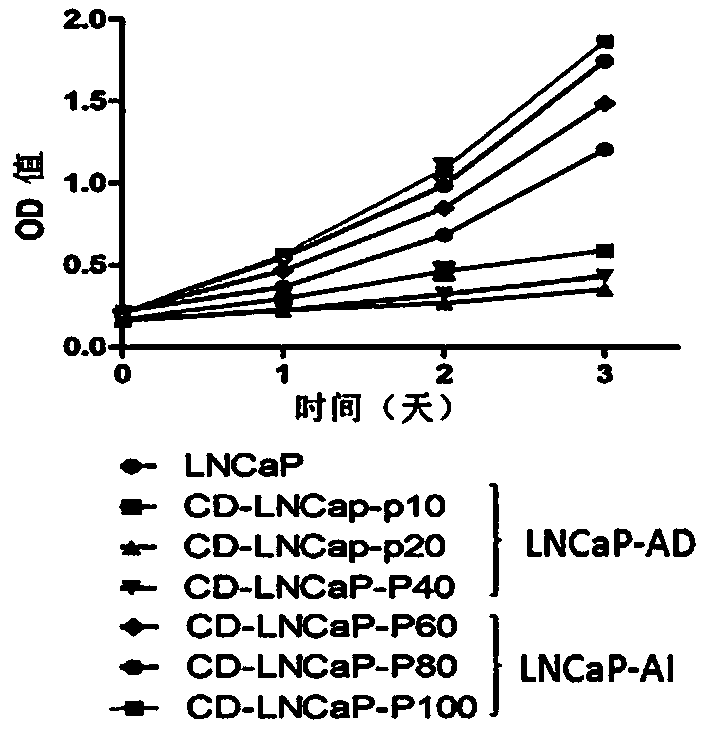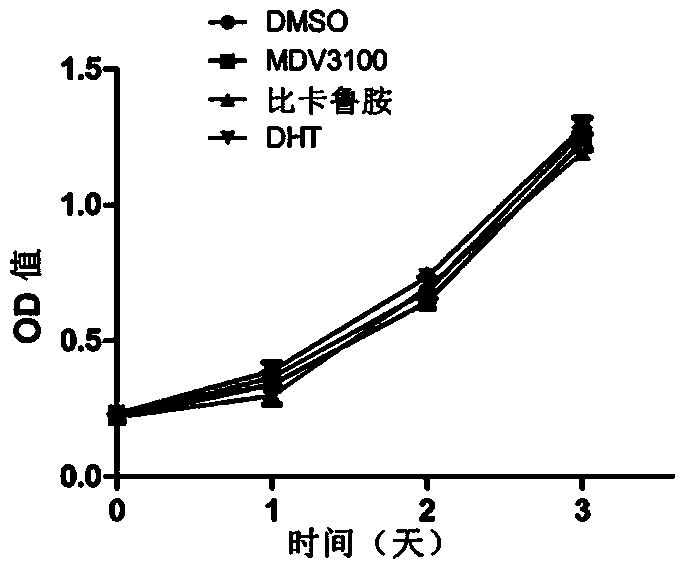Application of AR-V7 variable shearing sequence in resisting castration resistant tumors
An AR-V7 and sequence technology, applied in the field of biomedicine, can solve problems such as elevated PSA
- Summary
- Abstract
- Description
- Claims
- Application Information
AI Technical Summary
Problems solved by technology
Method used
Image
Examples
Embodiment 1
[0084] Example 1 Construction and verification of positive castration-resistant prostate cancer cell line LNCaP-AI
[0085] 1. Androgen-free culture of cell lines
[0086] The androgen-dependent prostate cancer cell line LNCaP was cultured in RPMI-1640 medium with 10% activated charcoal androgen-depleted fetal bovine serum. Cells were cultured in a cell incubator at 37°C, 5% CO 2 .
[0087] 2. MTT method to detect cell proliferation activity
[0088] Count the cells to be tested and dilute to 2×10 4 / ml, inoculate in 96-well plate, add 100μl cell diluent to each well, about 2×10 3 Cells / well, 4-5 replicate wells were set for each group of experiments to reduce errors. Place at 37°C, 5% CO 2 Culture in the cell incubator, take out the 96-well plate 1, 2, and 3 days after inoculation, carefully suck off the cell culture medium and add 100 μl of 1×MTT solution to each well of the well to be tested, incubate for 4 hours in a 37°C incubator, and carefully suck out the upper Fo...
Embodiment 2
[0112] Example 2 The effect of CYTOR on the expression level of AR-V7 in castration-resistant prostate cancer cell lines
[0113] 1. Cell culture
[0114] LNCaP-AI and 22Rv1 cells were cultured in six-well plates in vitro, and cells were transfected 24 hours after plating.
[0115] 2. Transfection
[0116] 1) Design of shRNA
[0117] A short hairpin RNA targeting CYTOR (shCYTOR) and a control (shSCR) were designed and synthesized for the binding sequence of the long non-coding RNA CYTOR and AR-V7.
[0118] The shCYTOR sequence is as follows:
[0119] 5'-TCTATGTGTCTTAATCCCTTGTCCT-3' (SEQ ID NO.1)
[0120] Sequence of shSCR:
[0121] 5'-TTCTCCGAACGTGTCACGTTT-3' (SEQ ID NO.2)
[0122] 2) Lipofectamine transfection
[0123] Using Roche's Lipofectamine 2000 kit, the short hairpin RNA synthesized in vitro was mixed with liposome transfection reagent to transfect prostate cancer cells. For details, see the instructions.
[0124] 3. QPCR detection of CYTOR mRNA level in cells ...
Embodiment 3
[0142] Example 3 Bioinformatics prediction and evaluation of AR-V7 variable splicing functional sites
[0143] 1. Determination of the unique structure of AR-V7
[0144] 1) Use the gene module in the NCBI database to select the full-length transcript of the AR gene (androgen receptor[Homo sapiens(hTman)]), namely AR-FL (NM_000044.4), and the transcript 3, namely AR-V7 (NM_001348061.1 ) nucleic acid information;
[0145] 2) Use the Graphics module to compare the mRNA structures of AR-FL and AR-V7, and analyze the unique structure of AR-V7;
[0146] 3) Use the FASTA module to align the mRNA sequences, analyze the cleaved signal sequence, and determine the alternatively cleaved sequence of AR-V7.
[0147] 2. Analysis of alternative splicing functional sites
[0148] Use the HSF 3.1 module of the HTman Splicing Finder online prediction evaluation website, select Splice site analysis, enter the gene name AR, continue to select the transcripts identified in step 1, and use the ma...
PUM
 Login to View More
Login to View More Abstract
Description
Claims
Application Information
 Login to View More
Login to View More - R&D Engineer
- R&D Manager
- IP Professional
- Industry Leading Data Capabilities
- Powerful AI technology
- Patent DNA Extraction
Browse by: Latest US Patents, China's latest patents, Technical Efficacy Thesaurus, Application Domain, Technology Topic, Popular Technical Reports.
© 2024 PatSnap. All rights reserved.Legal|Privacy policy|Modern Slavery Act Transparency Statement|Sitemap|About US| Contact US: help@patsnap.com










